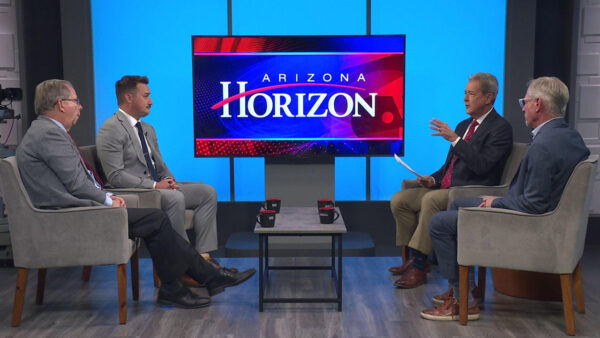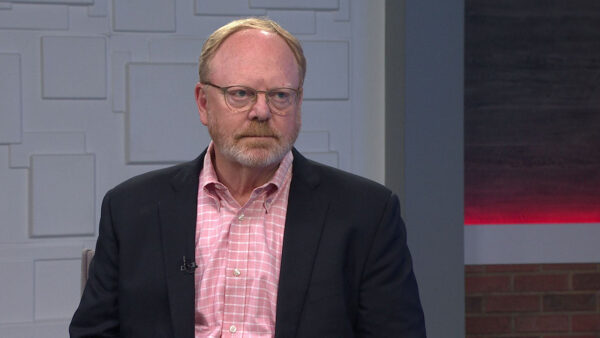Questions were raised about the “militarization” of local police forces following the shooting of an unarmed 18-year-old man in Ferguson, Missouri, but now it appears that support is growing for police being armed with military-style weapons following terrorist attacks. Scott Somers, a former Mesa City councilman, senior fellow at the GW Center for Cyber and Homeland Security and Professor of Emergency Management at Arizona State University, will talk about the pressures police face in determining whether or not to militarize their departments.
Ted Simons: A series of police shootings around the country is leading to concerns over what some perceive as the increasing militarization of local police departments, but the issue turned after recent terrorist attacks, increased support for supplying law enforcement with military style gear, and weapons. Here now to discuss the issue is former Mesa councilman Scott Somers, a fellow with the gw center for Cyber and Homeland Security, and ASU professor of emergency management. Good to see you again.
Scott Somers: Good to be here.
Ted Simons: Militarization of local police departments, what are we talking about here?
Scott Somers: When you think about the militarization of police, you envision what some call tanks, they are armored personnel carriers. You see police officers carrying heavier weapons, such as an m16 or air 15, multiple proof vest and helmet, something you would expect on a battlefield in Iraq or Afghanistan.
Ted Simons: How much are they stockpiling these things?
Scott Somers: Police departments have been stockpiling these and getting them off the department of defense, really, since 1996. That's when Congress approved the use of the DOD, the 1033 program, transitions, material from the department of defense over to the local police agencies, and in 1996, Congress added the use of, for anti-drug trafficking and terrorism activity.
Ted Simons: Now, but correct me if I am wrong, didn't that 1030, didn't something change with that, somewhat recently, as far as the department of defense handing out these things?
Scott Somers: Right. President Barack Obama here previously in May, made some changes, based on what was seen in Ferguson. So, it put some limits on the types of equipment that police agencies could obtain, for example, with the emraps who can't have tracked but only wheeled vehicles. Realistic, the police departments weren't getting the tracked vehicles. They are not getting aircraft that are armored, those things, but what it really did do is it added another layer to, of reporting and made it more difficult for policing agencies to get some of this equipment.
Ted Simons: More oversight, I would imagine?
Scott Somers: Far more oversight, and makes it difficult, certainly.
Ted Simons: And I mentioned at the top, the dynamic here, on one side, you are saying these police shootings and people are saying something is going on, and they are seeing the, seeing the police decked out in this gear, not comfortable. You are seeing San Bernadino, and what happened in Paris, and you want to see local police officers decked out in whatever they need to do to have to get the job done. Where are we now in this debate?
Scott Somers: Well, that's what we have now is a debate, and it's quite frankly, a very healthy debate. On one hand, local law enforcement still does what police have always done, right, they catch bank robbers. They hand out speeding tickets. They do a myriad of public services. But, really, policing faces a new threat that started back in 2008, after the Mumbai attacks. What we saw are terrorists, acting in cities, in a way that we had not seen before. They are well coordinated, they are using military equipment. They are using military style tactics, in an effort to get a high body count. Previously, much terrorism was about how much money we can get or can we get a political prisoner free. Today, well, now we're looking at a whole different threat.
Ted Simons: Is that tilting the equation more towards militarization?
Scott Somers: Well, I think that it certainly raises the question where you can see where this equipment has benefit. When you saw the apprehension of the terrorists in San Bernadino, they were using the same style of equipment, the EMRAPS that pulled up, both to equity from the officers, but protect civilians, as well, and so it's the application of the equipment, and the tactics used, that's really the question. When and where do you use them.
Ted Simons: Exactly, I think what concerns most people, routine raids, search warrants, and these sorts of things, they don't want to see a combat soldier knocking on their door.
Scott Somers: Certainly, and I think that that's a legitimate concern, when you have a low level drug offender, with no history, utilizing battle tactics for a lack of a better term, in that apprehension, is that going too far? On the other hand, you can see clearly what happens when police are not properly armed, because Colorado springs, planned parenthood shooting, one officer did what he needed to do, and got himself between the people being shot, and he was shot ultimately himself. This was an individual one might argue, needed to be better armed and better equipped with some of the material that we're seeing out of the dod program.
Ted Simons: It sounds like the question is, the question will be our police officers, peace-keepers or warriors.
Scott Somers: We should never think of police officers as war fighters. We are not fighting a war. What we are -- what they need to be, in my opinion, and keep in mind I am not a police chief, but what they need to be are peace-keepers, but they need to be ready to inter-dict with international signatures. A terrorist attacks is an unusual attack, but it will be front line officer that is the first responder to that incident, and that's who we expect to stop the terrorist attacks.
Ted Simons: So last question, I mean, is increased militarization, is that the new normal? Where do we go from here?
Scott Somers: I think that where we go from here is we need to continue to have the discussion, with our local policing, and ultimately, the answer is, multi-fold, but one, police clearly need to have access to this equipment. The question is, when should they be allowed to utilize the equipment? How is an institute, local police chiefs need to work with their community on answering that question, and ultimately, though, the concepts of community policing, engaging police officers, not only with the minority, but immigrant and religious group community, that's going to be the front line to preventing these attacks.
Ted Simons: That application is the bottom line?
Scott Somers: Absolutely.
Ted Simons: All right, good to see you again and thanks for joining us. We appreciate it.
Scott Somers:Former Mesa City councilman, senior fellow at the GW Center for Cyber and Homeland Security and Professor of Emergency Management at Arizona State University























